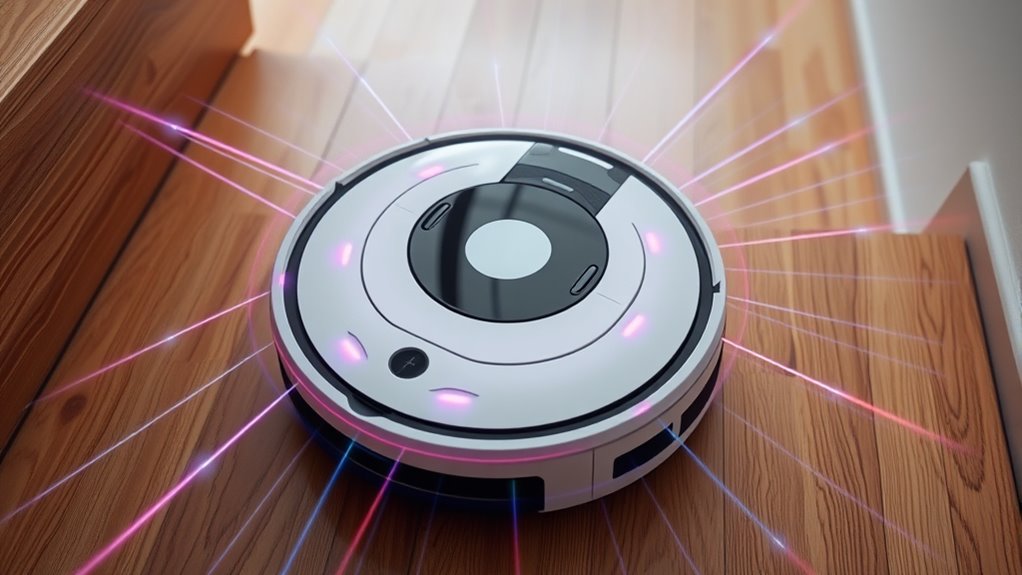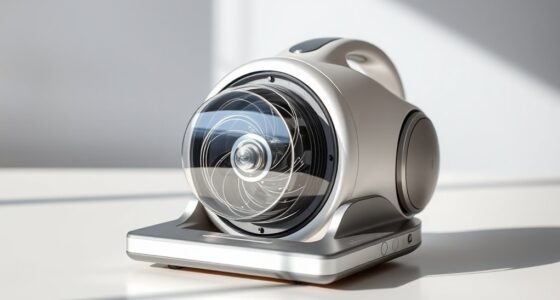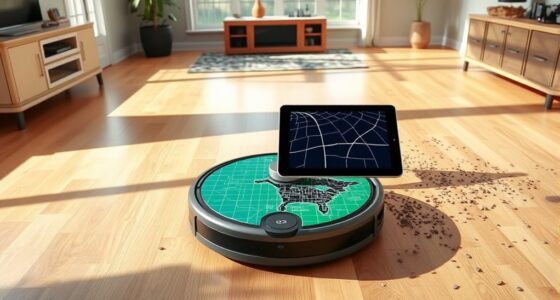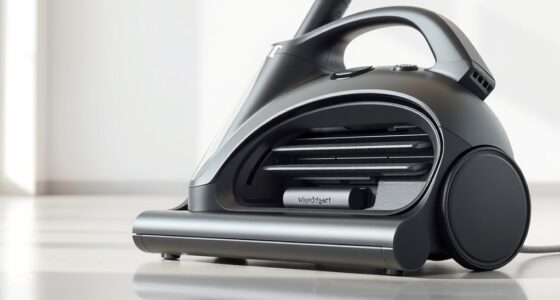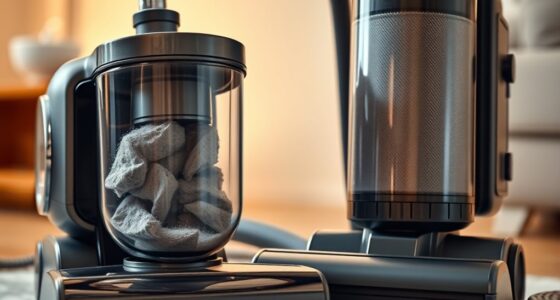Edge-detection technology helps robotic vacuums recognize stairs and drop-offs by analyzing sensor data from infrared or laser sensors. These sensors detect changes in surface height and identify edges, like staircases or abrupt drops, preventing your vacuum from falling. Advanced algorithms interpret this data in real-time to stop the device before it reaches danger zones. Understanding how these systems work reveals the smart safety features that keep your vacuum and home safe—keep exploring to learn more.
Key Takeaways
- Edge detection identifies boundaries and changes in surface levels to recognize stairs and drop-offs.
- Sensors are calibrated to distinguish real edges from shadows or rugs, preventing false alarms.
- Advanced navigation algorithms analyze sensor data in real-time to avoid approaching stairs.
- Continuous sensing and interpretation enable vacuums to adapt to environmental changes safely.
- Proper calibration ensures accurate edge detection, preventing falls and maintaining reliable operation.
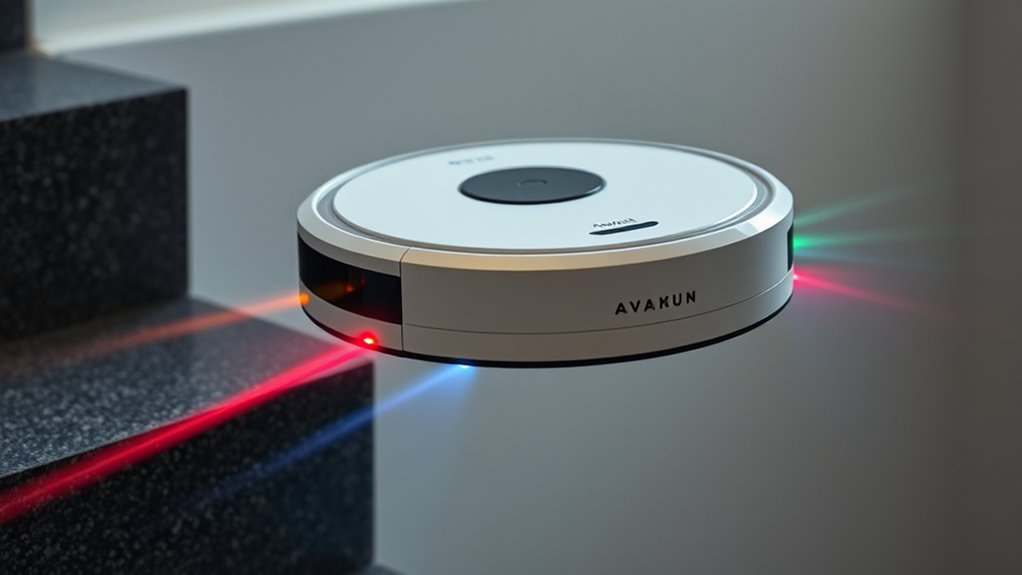
Edge-detection technology plays a vital role in image processing by identifying boundaries and shifts within visual data. When it comes to robotic vacuums navigating your home, this technology is critical. It allows these devices to recognize obstacles, changes in floor levels, and edges such as stairs. To do this effectively, the vacuum relies on sophisticated navigation algorithms that interpret the data gathered by its sensors. These algorithms process the visual and spatial information to determine where the edges are and how to move without falling.
The accuracy of edge detection depends heavily on sensor calibration. Proper calibration ensures the sensors can accurately detect subtle changes in the environment, like the transition from a flat floor to a staircase. When sensors are well-calibrated, the vacuum’s system can distinguish between a shadow or a rug’s border and a real drop-off. This calibration involves adjusting the sensors to account for lighting conditions, reflective surfaces, and other environmental factors, making sure the device’s perception aligns with reality.
Navigation algorithms are at the core of this process. They analyze the data from the sensors, which might include infrared or laser sensors, and create a map of your space. These algorithms continuously update their understanding as the vacuum moves around, identifying edges and obstacles in real-time. When approaching a potential drop-off, like stairs, the algorithms interpret the edge data to prevent the vacuum from approaching too close. The combination of sharp edge detection and intelligent navigation ensures the device can plan its route efficiently, avoiding falls and collisions.
Sensor calibration plays a crucial role here, too. If sensors aren’t calibrated properly, the vacuum might misinterpret an edge or fail to detect one altogether, leading to potential accidents. Regular calibration helps maintain the sensors’ sensitivity and accuracy. This process involves testing the sensors against known references, adjusting their settings, and sometimes recalibrating after software updates or changes in the environment.
In essence, edge detection combined with well-calibrated sensors and smart navigation algorithms creates a reliable system that keeps robotic vacuums from falling down stairs. It’s a continuous cycle of sensing, interpreting, and adapting that makes these devices efficient and safe. Without this technology, vacuums would struggle with basic navigation tasks, and your home’s safety could be compromised. Through precise edge detection and constant environmental assessment, these robots can clean thoroughly without risking damage or mishaps, giving you peace of mind as they work around your living space. Additionally, ongoing advancements in sensor calibration techniques further enhance their ability to adapt to diverse environments.
Frequently Asked Questions
How Do Edge-Detection Sensors Differentiate Between Stairs and Clutter?
You might wonder how edge-detection sensors tell stairs from clutter. These sensors are calibrated to recognize the distinct edges of stairs, differentiating them from clutter by analyzing the shape, distance, and contrast. This calibration helps minimize false positives, ensuring the vacuum doesn’t mistake a table leg for a staircase. As a result, your vacuum accurately detects stairs and avoids accidents, providing safer cleaning without misinterpreting everyday objects.
What Are the Limitations of Current Edge-Detection Technology?
Ever wonder what limits edge-detection sensors? You might think they’re perfect, but sensor calibration challenges can throw them off, especially with tricky lighting or unusual surfaces. False positives can cause your vacuum to stop unexpectedly or miss hazards altogether. These tech limits mean you still need to monitor cleaning routes, as current sensors occasionally misjudge stairs or clutter, leaving you wondering if your device’s intelligence really matches your expectations.
How Do Vacuums Adjust Their Navigation in Real-Time?
You see, vacuums adjust their navigation in real-time by constantly calibrating sensors and updating obstacle mapping. They process data from infrared or lidar sensors, which detect edges and obstacles, ensuring they’re accurately calibrated to avoid errors. As you move through your home, the vacuum recalibrates, refining its understanding of the environment. This real-time adjustment helps it navigate safely around furniture, stairs, and other objects, maintaining efficient cleaning without falling.
Can Edge Detection Prevent All Types of Falls?
Imagine your robot vacuum approaching a small step, relying on edge detection. While it can prevent many falls, it doesn’t eliminate all risks due to sensor calibration issues or false positives. For example, a shiny floor might trick sensors, causing a false positive and unnecessary stop. So, edge detection can’t prevent all falls; it’s a helpful tool but needs to be combined with other systems for thorough safety.
How Does Lighting Affect Edge-Detection Performance?
Lighting conditions critically impact edge-detection performance because poor lighting can reduce sensor sensitivity, making edges harder to detect accurately. When lighting is bright and uniform, sensors operate at their best, guaranteeing the vacuum can identify stairs and obstacles reliably. Conversely, dim or uneven lighting can cause sensors to miss critical edges, increasing the risk of falls. To maintain ideal performance, make certain your environment is well-lit and avoid shadows that can confuse sensors.
Conclusion
Think of edge-detection as your vacuum’s guiding eye, a quiet guardian that senses the delicate line between safety and danger. Like a steady heartbeat, it pulses with awareness, steering clear of obstacles and staircases. This tech becomes your device’s compass, turning chaos into harmony. With each detected edge, your vacuum moves confidently, a symbol of precision and trust. Together, you and this technology dance smoothly, avoiding falls and embracing a safer, smarter clean.
